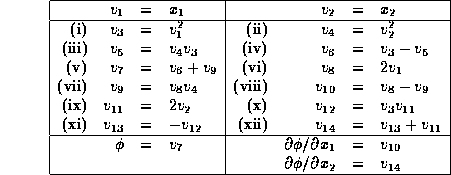is to be optimized over
When the expressions defining the objective function, gradient, and constraints are evaluated, intermediate quantities are computed. Under certain circumstances, the relationships among these intermediate quantities can be used, other than in the straightforward way for evaluating the dependent variables, to obtain tighter bounds on the dependent variables or to obtain a conclusion that no optimum can exist within the given box.
For example, suppose
![]()
is to be optimized over
![]() .
The global optimum of
.
The global optimum of ![]() over
over ![]() is 0, and the unique
optimizer is
is 0, and the unique
optimizer is ![]() . If
. If ![]() is programmed as
is programmed as
T(1) = X(1)**2
T(2) = X(2)**2
PHI(1) = T(1) - T(1)*T(2) + T(2)
then an early version of GlobSol, compiled with the NAG compiler version 2.1, produces the following list of intermediate operations.

(Different compilers will produce different decompositions,
or code lists.)
Suppose we know a sharp upper bound ![]() on the global
optimum, and suppose the sub-box
on the global
optimum, and suppose the sub-box
![]() is to be processed. An initial evaluation
of the code list (i.e. a forward substitution) gives:
is to be processed. An initial evaluation
of the code list (i.e. a forward substitution) gives:

Thus, since ![]() and
and ![]() , the
box cannot be rejected just from the computed values. However,
we may set
, the
box cannot be rejected just from the computed values. However,
we may set ![]() , and solve for
, and solve for ![]() in (v):
in (v):
![]()
We may now solve for ![]() in (viii), obtaining
in (viii), obtaining
![]()
Since ![]() (with
(with ![]() ),
),
![]() cannot contain both the global optimum and a critical point
of
cannot contain both the global optimum and a critical point
of ![]() . Thus, the box
. Thus, the box ![]() may
be rejected.
may
be rejected.